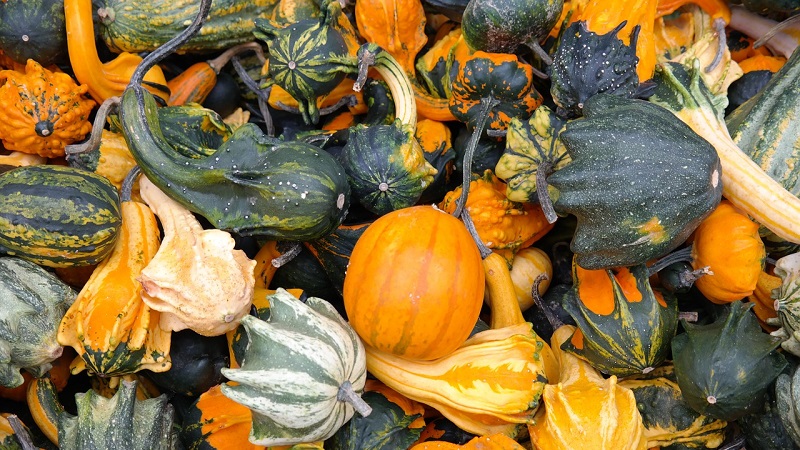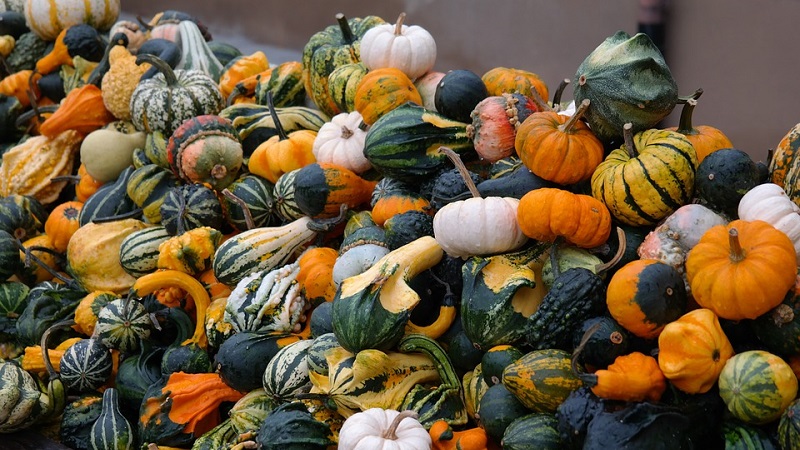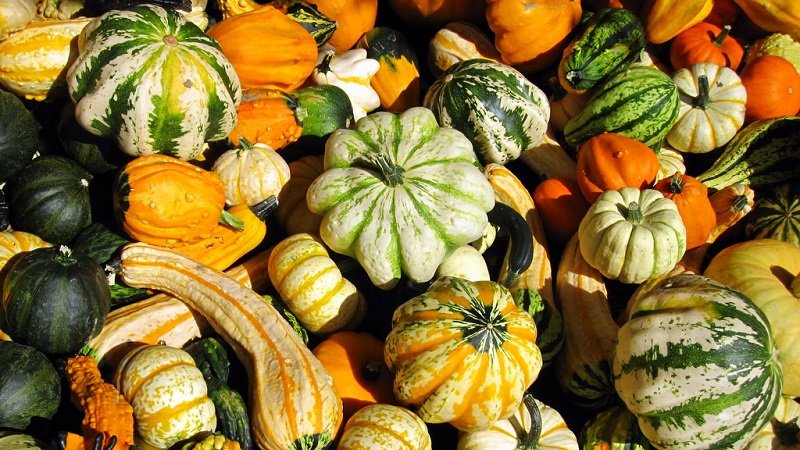What a decorative pumpkin looks like: growing unusual fruits and creating works of art
Summer residents often decorate areas with flowering plants. But exotic-looking vegetables do the job just fine. Ornamental pumpkin is one of the most interesting crops in this regard. It is able to tie on any vertical support and rise up, thereby forming a green wall with yellow flowers and small bizarre fruits. Neighbors and passers-by will be delighted to see such a landscape.
In the article we will tell you what a decorative pumpkin is and how to grow it correctly in your own garden.
The content of the article
What is a decorative pumpkin
Ornamental pumpkin is divided into two subspecies - bush and curly. They differ in the form of development of lateral lashes. If you need spot gardening of a balcony, terrace or open area, it is better to plant a plant in the form of a bush. Curly is capable of creating "green screens" up to 2.5 m high.
The maximum growth of green mass occurs in June. In early July, pumpkins bloom actively. Large beautiful flowers of various shades deserve special attention. Closer to August, the lashes will be adorned with fruits of intense shades of unusual shape. As it ripens, the color saturation increases.
Why is a decorative pumpkin worth growing
The reasons for planting bizarre varieties:
- Aesthetic aspect - pumpkin bushes look beautiful and unusual. They have bright yellow, orange, green flowers, unique leaves and impressive original fruits.
- Rapid growth of bushes. Within a month, they grow up to 5 m in length, so the culture is used for vertical gardening of country yards or a garden.
- Easy care, since the plant is unpretentious. It is enough to regularly water the bushes so that there is no wilting.
There are many ornamental varieties available at gardening stores. For example, orange varieties are popular with vegetable growers, which differ from other varieties in bright orange color.

How it is used in decor
The main application is decorating landscape design in a rustic Provence style. For this purpose, supports or trellises are made in advance along the fences. Also, nondescript outbuildings or walls of houses are decorated with culture. The rapid growth of green mass in a short time will cover buildings or form a living canopy in an open area.
The second area of application is the manufacture of handicrafts. Depending on the shape, cases, pots, vases, candlesticks and other interior items are made of pumpkin.
Types of decorative pumpkins
In horticultural stores, you can find packages with a mixture of a wide variety of decorative varieties.
The most common:
- warty;
- pear-shaped;
- pumpkin-crowns.
Review of the best varieties
The decorative pumpkin has been known as a culture for a long time. Depending on the shape, it is called dishware or bottle. In ancient Rome, various containers were made from the fruit, such as barrels for wine.
In ancient China, the ornamental pumpkin was treated like the queen of plants. It was specially grown in the imperial gardens for making bowls.The dishes were used to set tables for special guests. In Africa, to this day, dishes and the famous African tam-tam are made from well-dried pumpkins. They also make various souvenirs - decorations, snuff boxes, etc.

Mandarin duck
Mandarin is orange in color. The shape is similar to orange and tangerine. Small fruits weigh up to 300 g and look spectacular against the background of dense green foliage.
Warty
Warty gourds vary in shape and size. They are pear-shaped, round, oval, star-shaped or bottle-shaped. The color range is from white to yellow, orange and dark green, almost black. At the same time, there are also two-colored - spotted or striped.
Warty vegetables have an uneven surface - in nodules and tubercles. The climbing plant has thin lashes that grow up to 3-4 m. This variety is recommended to be planted in seedlings in March-April and transferred to open ground in June. Up to 30 small fruits ripen on the plant (slightly more than 10 cm in diameter). The variety is excellent for decorative purposes.
Turkish turban
The Turkish turban is an edible variety that differs from its relatives in its growth rate. In a few weeks, the culture grows up to 6 meters. Rapid growth allows the plant to be used to organize vertical gardening of the personal plot.
Pumpkin is considered a light-loving plant, so it is grown in well-lit places. Ornamental fruits are small in size, up to 15 cm in diameter.
Crown
Variety "crown" has a small size of fruit, resembling an asterisk with different colors - orange, yellow, green, striped. The culture is planted in the last decade of April or at the beginning of May, from the middle of June the color begins to appear, from July the ripening of pumpkins. The fruits are harvested in October. The variety is used to decorate the outer walls of houses and other buildings.
Mini Pumpkin Sweet Dumpling
Sweet Dumplinq fruits are great for decorative purposes and are white in color with orange or green stripes. The vegetable can be eaten - it has a sweet pulp with a fruity aroma.
Little Boo
"Little Boo" is considered a unique pumpkin variety due to its perfectly white color. Each weighs up to 200 g, size is 10-15 cm in diameter. The surface of the fruit is absolutely flat and smooth. Ripe vegetables look beautiful and are used not only as decoration, but also for cooking.
Jack be little
This variety is similar to the "orange" variety, since the fruits are also painted in bright orange colors and have a diameter of about 10 cm. The bushes of this culture are fruitful, each plant ripens up to 15 fruits, which weigh 100-120 g. The variety is used both for decorating the site, and for cooking vegetable dishes.
Kleine bicolor
The fruit of this pumpkin is shaped like a pear. Mature vegetables come in a variety of colors, but green is more common.
Smile
Variety "smile" - sweet and juicy, tolerates unfavorable weather well and is stored until next year, edible fruits ripen in August.
Features of growing decorative pumpkin
Growing seedlings includes a number of the following actions:
- preparation of seed material - disinfection, hardening, germination;
- sowing seeds for seedlings is carried out in late April - early May;
- the culture does not like transplanting, therefore, one seed is sown in a pot with a diameter of at least 15 cm;
- after 12 days, sprinkle the plant with earth, until the cotyledon leaves;
- we feed the seedlings twice with mineral fertilizers or liquid manure;
- we transplant the seedlings after 30 days, when it has five true leaves;
- before planting, weed the ground and apply fertilizers;
- make holes for the plant and pour 1 liter of water into each.
Also, the seeds take root well if they are sown directly into the ground. This is done after the frost has irrevocably passed - the soil temperature should be at least 13 ° C.
When growing a crop, the following conditions will need to be met:
- timely watering and feeding the plant, loosening the soil and removing weeds;
- installation of a reliable structure to support the plant;
- pinching of the central shoot, which has grown to one meter, so that lateral processes are formed;
- inspection of the plant for the timely detection of pests and diseases;
- after full ripening - collection of fruits (before frost).
Important! The area for growing crops should be sunny, the land should be well warmed up. The plant is afraid of frost.

Further application
Decorative pumpkins are used to create applied items - in particular, dishes for storing food and water or for use as decor in the interior. To prevent small pumpkins from rotting, the fruits must be harvested before the fall frost. For crafts, fruits with a thick, rough skin are deposited.
Drawings are applied to bright fruits and varnished. Useful and beautiful things are made from fruits. For example, containers for storing cereals, flower pots, birdhouses, boxes, bottles and scoops.
How to dry pumpkin for crafts and decorations
From the entire harvested crop, only fully ripe fruits are left, which have a dry stalk and a dense crust. To determine the degree of maturity, the pumpkin is carried out with a fingernail. It is difficult to scratch a mature hard shell. The dry rind of lagenaria (gourd gourd) has a brownish-yellowish tint.
The selected fruits are thoroughly washed with soap, wiped and allowed to dry, then wiped with alcohol and placed in a dry, warm room until completely dry.
After the bottle gourd is dry, it is moved to a place where the fruits will lie for six months. Lagenaria needs a ventilated place where direct sunlight will not fall on it.
On a note.If the pumpkins are damaged, they start to rot. They need to be removed to prevent fungi and bacteria from infecting nearby healthy pumpkins.
Periodically, workpieces should be inspected for signs of mold. If it appears, additional treatment of the shell with an antiseptic is required. A soaked rag in chlorine bleach will also help get rid of mold, but only if the skin has retained its density.
When the pulp dries, the outer color of the shell darkens. When the lagenaria dries up, it will become very light. If you shake her, seeds will rattle inside. If you throw a dry gourd into the water, it will float on the surface.

How to determine the edibility of a variety yourself
Can a small pumpkin be eaten? In most cases, no. All small pumpkins with a diameter of no more than 15 cm form a seed chamber and a thin layer of flesh, which dries up when ripe. The smaller the fruit, the faster the ripening and drying process of the pulp will take place.
For your information. There are no toxic substances in pumpkin. But low-edible fruits have a tough, dry pulp with a minimum amount of sugar, which significantly reduces the nutritional value of the product.
Reviews
There are a large number of decorative varieties and each has a difference in the shape and color of the fruit. Those who have already grown the culture speak of it mostly positively. The advice of experienced gardeners will help you decide on the choice of a particular variety.
Tatyana. “The Turkish turban is my favorite variety. Neighbors advised me to grow it. The pumpkins are small and compact. Plant care is quite simple. I water it together with other flowers. The soil on my site is light loamy. It absorbs water immediately and dries quickly. Sometimes, in hot weather, the leaves of the plant wilt. But by the evening they are recovering again. A couple more times I poured nitroammophoska on a tablespoon. The scourge has to be cut off as it clogs other plants. This variety is edible. So, I cut off the top from them, take out the pulp and stuff with minced meat, then close it with a lid and put it in the oven until tender.It turns out very tasty, you just lick your fingers. The pumpkin itself tastes like potato. "
Michael. “Recently, I have been planting a decorative pumpkin Wart mixture in my country house. I love vertical gardening. Pumpkins can decorate a garden, cottage or even a balcony well. My children love them very much, they make crafts out of them. I plant the seeds for seedlings in April, then transplant them in large buckets in May and send them to the greenhouse, and only then I expose the buckets with plants outside in mid-May, they will definitely need a garter support. In a greenhouse climate, they simply grow at a cosmic speed. I really liked the culture, good germination, strong seedlings. Seeds are very inexpensive, and how much beauty and variety they add to gardens. If you like something unusual, I advise you to plant Wart mixture, these fruits grow the same as in the photo on the package, of various shapes and colors. "

Conclusion
Growing a variety of decorative pumpkins will be an interesting activity for both a novice gardener and an experienced gardener. A mixture of varieties looks especially impressive.
Do you want to surprise your guests and neighbors with bright and bizarre fruits or decorate your home interior? Grow ornamental pumpkin varieties. The cultivation process is extremely simple - the main thing is to take care of providing the proper conditions for the growth of the crop.